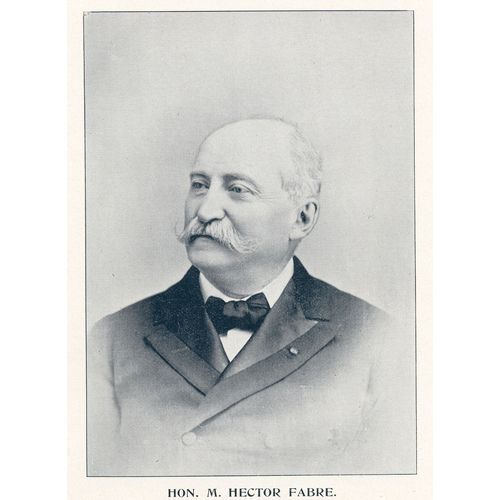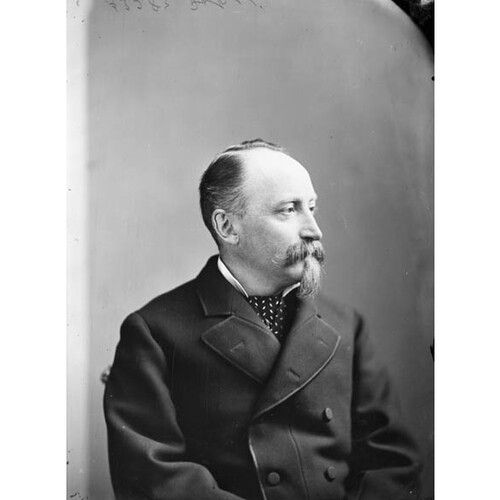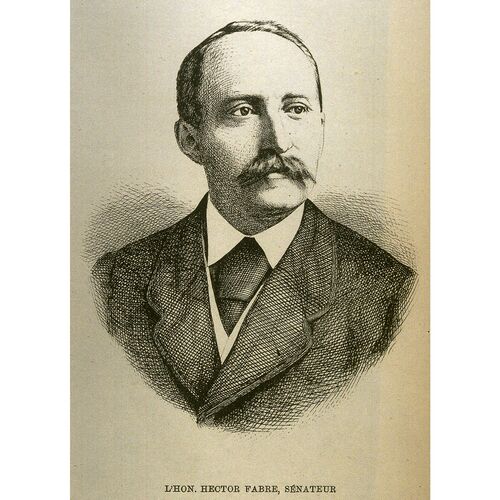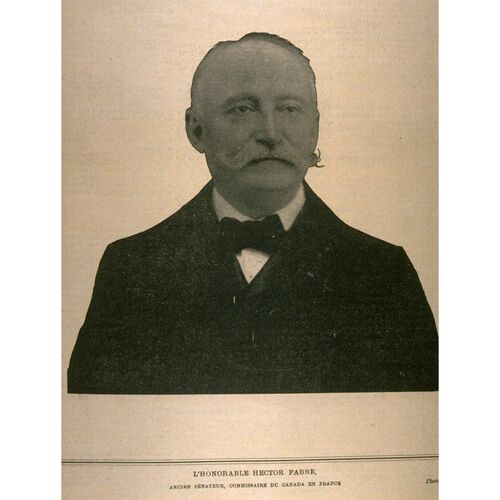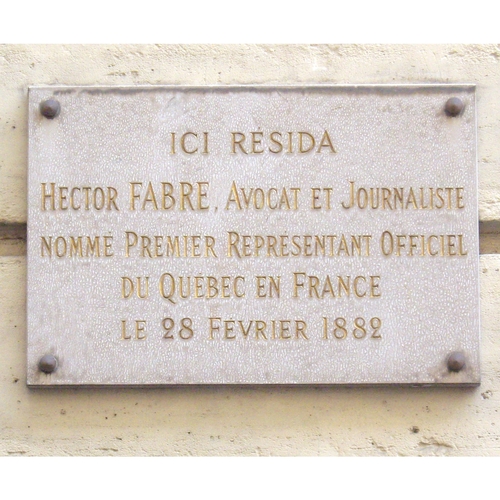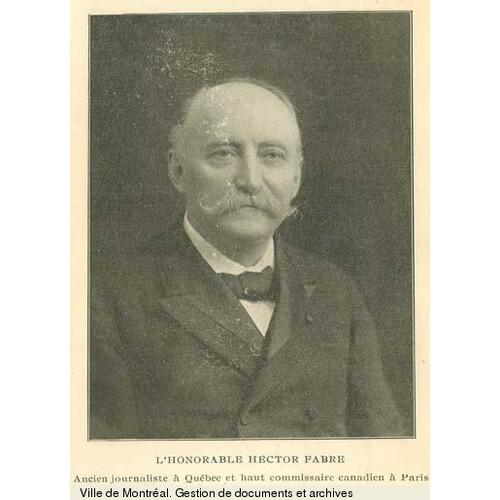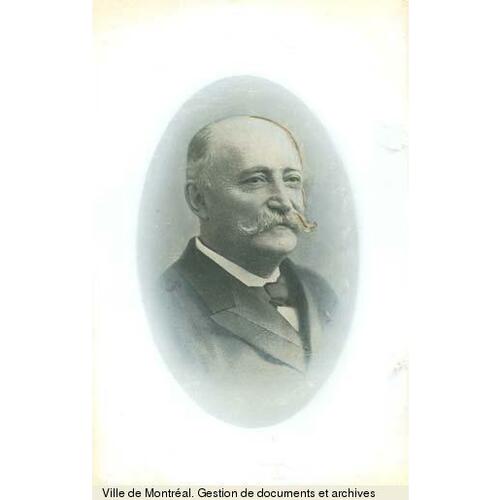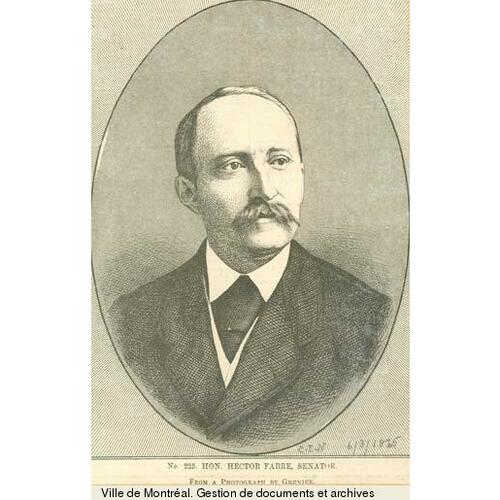As part of the funding agreement between the Dictionary of Canadian Biography and the Canadian Museum of History, we invite readers to take part in a short survey.
FABRE, HECTOR (baptized Louis-Roch-Hector), journalist, newspaper owner, diplomat, and senator; b. 9 Aug. 1834 in Montreal, son of Édouard-Raymond Fabre* and Luce Perrault; m. 3 Aug. 1864 Flora Stein in Arthabaskaville (Arthabaska), Lower Canada, and they had one son; d. 2 Sept. 1910 in Paris.
Hector Fabre was the nephew of two Patriote leaders, Louis* and Charles-Ovide Perrault. His aunt Julie Fabre, who lived in Paris, was married to bookseller Hector Bossange. He had two brothers, Édouard-Charles*, who became the first archbishop of Montreal, and Gustave-Raymond, and two sisters, Hortense, who wedded George-Étienne Cartier* in 1846, and Hectorine. Through his wife, whom he married under the regime of separation as to property, he established connections with the élite of Arthabaskaville. Adolphus Stein, his father-in-law, was said to be a Jew from Leipzig, Germany, who had converted first to Lutheranism and then to Catholicism; he would become warden of Arthabaska county and later mayor of Arthabaskaville.
Hector Fabre studied with the Brothers of the Christian Schools in Montreal from 1842 to 1845, and then went to the Collège de L’Assomption. After one semester (September to December 1845) he transferred to the Petit Séminaire de Montréal. He took the third year (Method) of the classical program at Saint-Hyacinthe, spending 11 months there, and then returned to the Montreal seminary, where he finished his studies. His father, a bookseller, initiated him into the universe of books and newspapers. When he was still a boy he entered the world of ideas, listening to such leaders of the day as Louis-Hippolyte La Fontaine*, Augustin-Norbert Morin*, Edmund Bailey O’Callaghan*, and Édouard-Étienne Rodier*, who “used to meet every afternoon in my father’s bookstore to talk about current events.” Denis-Benjamin Viger*, Ludger Duvernay*, and Louis-Joseph Papineau* eventually joined the circle, and Papineau and O’Callaghan would become two of his father’s most faithful friends. All three were at Saint-Denis on the Richelieu in November 1837, and it was the elder Fabre who urged the two Patriote leaders to flee to the United States. He and his wife hid with young Hector for a while in Lavaltrie and later in Contrecœur. In November 1838 Fabre was finally arrested. His wife had a miscarriage; one brother-in-law, Charles-Ovide Perrault, the member of the assembly for Vaudreuil, had been killed in the battle at Saint-Denis the previous fall, and the other, Louis Perrault, the owner of the Montreal Vindicator and Canadian Advertiser, had gone into exile.
Although he was too young to understand what was happening, Hector Fabre would remain profoundly influenced by these events. The years that followed were taken up with efforts to facilitate the exiles’ return and to keep alive the memory of those who had died. It was no accident that one of the first pieces Fabre wrote dealt with the late Chevalier de Lorimier*, about whom he had given a talk before the Institut Canadien in Montreal. Fabre had been a member of this organization since 1851 and became its librarian in 1858. That year he helped found the Institut Canadien-Français [see Ignace Bourget*]. His early writing was strongly imbued with nationalism. In a lecture entitled Confédération, indépendance, annexion, which he gave to the Institut Canadien in Quebec on 15 March 1871, he condemned the policy of Great Britain, which had been designed not “to allow us to remain French . . . but to remake us gradually in [the] age [of that country], to merge the ancient majority and the new minority into a single nationality.” In his view the British conquest had been an utter catastrophe. He was quick to denounce the “spirit of tyranny and persecution that followed.” Doubtless influenced by Tocqueville, he asserted: “The greatest misfortune that can befall a nascent people is to be separated from the nationality of its origin, to be isolated from its roots; to see the past suddenly closed off behind it, while it makes its way, alone and unsupported, towards an uncertain future.”
Once he had finished being articled to Cartier, Fabre became a lawyer on 5 May 1856. The next year, after a long stay in Italy and Paris, where he attended the funeral of author Alfred de Musset, he went into partnership with Siméon Le Sage and Louis-Amable Jetté*. The three were firm friends, but soon each took a different direction.
For several years Fabre had written occasionally for the Montreal newspaper Le Pays, and now he opted for journalism. In 1858 he began working at Joseph Royal’s paper, L’Ordre. In 1863 he moved to Quebec City and Le Canadien, where François Évanturel* was an influential figure. At 33 Fabre founded his own newspaper, L’Événement, and he would remain its sole owner from 1867 to 1883. There were financial problems, however. Perhaps his wife and brother-in-law came to his assistance. It is unclear where A. Levy Recio, who in 1869 acted as the paper’s accountant (and in 1879–80 would be the business manager of the Quebec L’Éclaireur) came from. On 3 Oct. 1868 Fabre had received some money from his mother as an advance on his inheritance, at the same time relinquishing his share of the estate.
To finance his newspaper, Fabre went looking for political alliances. He involved himself in the Quebec municipal elections and in 1869 began getting advertising contracts from the city. Running in a federal by-election at Quebec on 28 March 1873, he was defeated “by a spoiled brat” named Adolphe-Philippe Caron, but soon consoled himself when, on 5 Feb. 1875, he was appointed to the Senate by the Liberal government of Alexander Mackenzie*. He then turned over his newspaper to Nazaire Levasseur*. In January 1877, with his wife and son, he was in Paris, where he had spent some time in 1857 and 1860. Apparently he could not keep still. He returned to Canada for a few weeks and rejoined his family in May. Two years later he was in Europe once more, visiting England, Switzerland, and France.
In September 1880 Fabre headed for Paris again. On his return, in May, he met up with his friend Joseph-Adolphe Chapleau*. Then premier, Chapleau left Quebec at the end of the session, along with Louis-Adélard Senécal* and their wives. Although Fabre’s role is not fully known, it is certain that he was involved in the negotiations that led to the founding of the Crédit Foncier Franco-Canadien. It is also clear that Chapleau, Senécal, and Fabre conceived at that time the plan to establish a permanent position in Paris for a provincial representative.
Early in 1882 a report was submitted to the cabinet concerning “the appointment of an agent general of the Province of Quebec in France, to reside in Paris.” In his capacity as a railway commissioner, Chapleau emphasized the increased role of “French capital,” “large-scale colonization projects” involving “French, Belgian, and Flemish farmers,” and the need to “facilitate relations between the promoters of these enterprises in Europe and the individuals or companies in this province who are associated with the enterprises, and especially . . . to facilitate and provide the information necessary for the success of these operations.” Since the operations in question “originated and are being developed in France, Belgium, and western Germany,” Paris was designated “the centre . . . most suitable.” Hector Fabre was to take up residence there as “the accredited representative of the government of Quebec for all negotiations falling within the jurisdiction of the province, acting therein under the instructions that he will receive from time to time from the government of Quebec.” Apart from his role in providing information, Fabre was given a clear economic mandate and the instruction that “until further orders, the said agent will report directly to the department of the premier.”
On 4 March 1882 the lieutenant governor approved the order in council of 28 February. Fabre and his wife were in seventh heaven. They both adored Paris where, according to historian Robert Rumilly*, Flora Fabre was to be “one of the prettiest women in the diplomatic corps, a petite but charming figure, both gracious and urbane.” But the city was expensive. It cost money to do an effective job and keep up appearances. Fabre, who mainly had incurred debts with L’Événement, found his annual salary of $2,000 and additional allowance of $500 for moving and office expenses somewhat meagre. It was not an obstacle to deter him – it could be dealt with later, the more so since the minor controversy surrounding his appointment suggested now was not the time to press the point. No sooner had Fabre reached Paris than he was joined by Chapleau and Senécal. He owed his appointment to them and he would also be indebted to them for a rapid improvement in his situation. Senécal, who intended to share Fabre’s office, set about equipping the necessary premises.
Chapleau, the premier, had just agreed to switch offices with Joseph-Alfred Mousseau*, a federal cabinet minister. This surprising exchange was engineered by Sir John A. Macdonald* in July 1882. Chapleau was then endeavouring to convince the federal government that it would also benefit by using the “Quebec” representative in Paris. Clearly the matter was complicated. What would London say? Although the initial reaction was negative, men such as Adolphe-Philippe Caron, Fabre’s former opponent in Quebec in 1873 and now minister of militia and defence, saw advantages in the proposal. Caron was of the opinion that if Fabre had a federal mandate, he might be forced to leave the Senate, thereby cutting the Liberal strength by one. Pierre-Antoine De Blois, the minister’s brother-in-law, could fill the vacant seat. Fabre in the end left the Senate in July and, “with the consent of the Government of Quebec,” agreed to represent the government of Canada as well “for a period not exceeding three years.” He would hold this double mandate until his death and throughout these years would receive a similar salary from each government.
When in 1910 the question arose of choosing a successor to Fabre, the Department of External Affairs, which had just been created, and Joseph Pope*, then a deputy minister, would interpret the 1882 arrangement and raise again the question of the authority of the high commissioner in London. Instructions dated 3 Oct. 1882, he said, required Fabre “to conform to any directions he might receive from the Canadian High Commission in London.” The whereabouts of these instructions has not been determined. Pope summarized them but did not quote them. It is known, furthermore, that the British ambassador in Paris was not overjoyed at Fabre’s arrival there and frequently refused to have anything to do with him. He considered himself as much the representative of the Dominion of Canada as of England. According to writer Gérard Parizeau, Princess Louise* (the wife of the Marquess of Lorne [Campbell*], who was governor general of Canada from 1878 to 1883) intervened personally. “If you do not want to receive the representative of Canada,” she told the British ambassador, “then at least receive my friend Monsieur Fabre.” They had, in fact, often met in Ottawa during the preceding years.
Fabre would be on easier terms with the Canadian high commissioner in London, Sir Alexander Tilloch Galt*, and especially with Sir Charles Tupper*, who succeeded him in 1883. Tupper was not bothered in the least by Fabre’s mandate, which mainly concerned the development of trade and commerce between France and Quebec or Canada. Fabre had quickly begun to dream of having a newspaper as a means of action. Two years after his arrival in France he founded Paris-Canada, which linked Canadians living in Europe and enabled him to disseminate information about Canada, its products, and its investment opportunities. In the first issue he explained the country’s political status as a “sort of sovereign state whose only constraint is to be faithful and pay homage to the power that has graciously granted it all the benefits of independence.”
The activities of Fabre the diplomat can be followed by reading Paris-Canada, which would be published more or less regularly until 1909. During his early years in office he travelled widely throughout France and had many speaking engagements. At the same time a constant stream of visitors from Quebec and Canada came through his door. Chapleau was in Paris in 1882 and again in 1893. Curé François-Xavier-Antoine Labelle* arrived in 1885. Honoré Mercier* was there as premier in 1888 and 1891 and as a private citizen in the winter of 1892–93. Deputy commissioner of public works Siméon Le Sage and his two daughters came in 1895, Sir Wilfrid Laurier* in 1897 and 1902, Joseph-Israël Tarte in 1899 and 1900, and Premier Lomer Gouin* in 1907. All this high society required a great deal of care and attention. Over the years Fabre built up a powerful network of friends. For politicians, he organized meetings at the highest level; for artists, he discovered opportunities and established important contacts. As a rule his work was appreciated. Sometimes he used it to ask for additional financial assistance.
Early in 1889 Flora Fabre took the liberty of writing to Premier Mercier. He had already indicated that he could refuse her nothing. Without special assistance the Fabres would have to sublet their apartment in Paris and spend the summer in the country. On 24 April 1889 the premier promised them $1,000, to be followed by an additional $2,000, enormous sums when one remembers that the annual salary paid by each government was $2,000. In June another letter arrived from Mercier, expressing great annoyance. He had heard that the Fabres had vacated their apartment for the summer anyway, and he expected them to deny this report. In July he had the second payment stopped. Mme Fabre explained that they had not heard about the grant until shortly after they had sublet their place. She mentioned that there were those who were jealous. On 29 July Mercier sent a cable to her. He made no promises; he would have to meet with his colleagues. On 14 August the grant was approved. In the spring of 1891 the Fabres would have an opportunity to show their gratitude to the premier, who announced that he was coming for six months. He arrived on 21 March 1891, accompanied by the provincial treasurer, Joseph Shehyn*, and full of plans. He wanted to negotiate an important loan, as he had done in 1888. In the main this mission, which ended on 7 July, was a success, despite the irritation of British financiers. Fabre inherited a few minor problems, however, including a herd of bulls, which British shipping lines refused to transport. On 7 August Mercier thanked Fabre and sent him a few personal bills to settle.
Chapleau, for his part, preferred wines to bulls. In 1892, as minister of customs, he was interested in importing them and hoped for direct negotiations between France and Canada. In October the British government gave its approval in principle. Although Chapleau resigned in November, a commercial treaty between Canada and France was signed on 6 Feb. 1893. This was the first treaty Canada signed with a European country. But objections arose and both parliaments delayed ratifying it. London re-examined its agreement and had still not ratified the document by October 1895. A new commercial treaty would finally be signed in September 1907.
The Fabres had one son, Paul. He became editorial secretary of Paris-Canada in February 1892 and editor two years later. Since the newspaper was supposed to be self-supporting, a paid position had to be found for him. On 2 Oct. 1896 the government appointed him secretary of the Quebec commission in Paris at a salary of $500. But his father’s salary would have to be reduced by this amount, on the recommendation of Hector Fabre himself, who had no doubt been hoist with his own petard. Fabre did not give up, however. He interceded more frequently with the federal authorities. As founder of the dramatic and artistic society Le Gardenia, and as an actor and theatre critic, Paul transformed the commission’s suite into a veritable cultural centre, which exerted an influence over the Parisian artistic community. His good humour and dynamic personality could not, however, hide his frail health. In 1901 and 1902 Hector pressed more urgently on his son’s behalf. The visit of Laurier and his wife in 1902 gave them new hope, but Paul died on 18 December.
Siméon Le Sage, who himself had needed time to get over the death of his wife in 1879, tried to get his old friend’s mind off his sorrow. He wanted to send his own son Jules to him for a while. Louis-Amable Jetté, who had been appointed lieutenant governor of Quebec in 1898, came over for three months in the fall of 1903 with his wife and their daughter. The friendship of Le Sage and Jetté was comforting to a father who, no doubt as a result of living abroad, was very close to his only son and had celebrated Saint-Jean-Baptiste day with him in Paris every year since 1887. Another tradition had been inaugurated in October 1893, when the society La Boucane was founded to combat the depression suffered by the “Canadian exiles” who had become increasingly numerous over the years. There were more visitors too, as a stream of artists, businessmen, and students came to 10 Rue de Rome, where since 1887 what was called the Canadian commission general had been housed. In France, Canada of course meant the federal government, but, more especially, the province of Quebec. Canadiens was a synonym for Québecois, or at least for French Canadians, the very people who had lived through a mass exodus to New England at a time when emigration from Europe was increasing. Nationalist circles in Quebec were calling for immigration from French-speaking countries. In 1902 it was estimated that four hundred immigrants came to Canada from France. Mainly at the insistence of journalist Olivar Asselin*, an immigration agent in Paris was appointed in 1903 in the person of Paul Wiallard. He would hold the title of assistant commissioner of Canada in France. Hector Fabre did not, however, sit with his arms folded. He set out again on his travels through France, gathering significant support among French Catholic clergy. But anticlerical circles were on the alert. The population of France was declining and any propaganda in favour of emigration was illegal. In his communications with External Affairs, the French consul in Montreal raised strong objections to the Canadian campaign promoting emigration. Georges-Benjamin Clémenceau, president of the council and minister of the interior in France, intervened personally in 1909. He issued an important circular pointing out the difficulties involved in adapting to life in Canada: hard work, an extremely harsh climate, problems of communication, and the importance of English. It may have influenced Fabre’s decision to stop publishing Paris-Canada in January 1910. A peak in the Canadian endeavour was reached that year, when two thousand immigrants came from France. Since the visit of La Capricieuse [see Paul-Henry de Belvèze*] in 1855, fewer than fifty thousand French citizens had emigrated to Canada, one-tenth the number that had gone to the United States. The successes of 1909 and 1910 were small consolation for Fabre, who by then was old and ill. He died quietly on 2 Sept. 1910 at Chesnay, near Paris, and was buried in the cemetery of Boulogne-sur-Seine beside his son.
A cultivated man of action Hector Fabre was jovial, a bit of a social climber, but a diplomat to the core. He had a knack of seizing the right opportunity, either for himself or for the two governments whose interests he defended so skilfully in France, a land he knew well and loved deeply. He paved the way for Canada on the international scene and laid the groundwork for official representation of Quebec in foreign countries.
Among the newspaper articles, addresses, and essays Hector Fabre published are the following: Esquisse biographique sur Chevalier de Lorimier (Montréal, 1856); “Causerie,” La St.-Jean-Baptiste à Québec (Québec, 1865), 63–79; Confédération, indépendance, annexion; conférence faite à l’Institut canadien de Québec, le 15 mars 1871 (Québec, 1871); L’élection du comté de Québec; pourquoi j’ai été battu ([Québec?, 1873?]); Chroniques ([Québec?], 1877); Le Canada . . . (Paris, 1884); Le Canada; conférence faite à Roubaix en avril 1886 (Lille, France, 1886); and three speeches published in Conférences et discours de nos hommes publics en France, Georges Bellerive, édit. (Québec, 1902), 135–71.
ANQ-M, CE1-51, 9 août 1834. ANQ-MBF, CE2-2, 3 août 1864. ANQ-Q, P-149. Centre de Recherche en Civilisation Canadienne-Française (Ottawa), P 159; Ph 84. NA, MG 26, G. Le Canadien, 28 juin 1865. La Presse, 28 févr. 1885. À la mémoire de Alphonse Lusignan: hommage de ses amis et confrères . . . (Montréal, 1892), 265–70. Raoul Dandurand, Les mémoires du sénateur Raoul Dandurand (1861–1942), Marcel Hamelin, édit. (Québec, 1967). L.-M. Darveau, Nos hommes de lettres (Montréal, 1873), 230–41. L.-O. David, Souvenirs et biographies, 1870–1910 (Montréal, 1911), 179–91. DOLQ, vol.1. Hamel et al., DALFAN, 491. J.-S. Lesage, Notes biographiques; propos littéraires (Montréal, 1931), 252–57. Gérard Parizeau, La chronique des Fabre (Montréal, 1978). Jean Piquefort [A.-B. Routhier], Portraits et pastels littéraires (3 tomes en 1v., Québec, 1873). J.-L. Roy, Édouard-Raymond Fabre, libraire et patriote canadien (1799–1854): contre l’isolement et la sujétion (Montréal, 1974). Armand Yon, Le Canada français vu de France (1830–1914) (Québec, 1975).
Cite This Article
Sylvain Simard and Denis Vaugeois, “FABRE, HECTOR (baptized Louis-Roch-Hector),” in Dictionary of Canadian Biography, vol. 13, University of Toronto/Université Laval, 2003–, accessed March 29, 2025, https://www.biographi.ca/en/bio/fabre_hector_13E.html.
The citation above shows the format for footnotes and endnotes according to the Chicago manual of style (16th edition). Information to be used in other citation formats:
| Permalink: | https://www.biographi.ca/en/bio/fabre_hector_13E.html |
| Author of Article: | Sylvain Simard and Denis Vaugeois |
| Title of Article: | FABRE, HECTOR (baptized Louis-Roch-Hector) |
| Publication Name: | Dictionary of Canadian Biography, vol. 13 |
| Publisher: | University of Toronto/Université Laval |
| Year of revision: | 1994 |
| Access Date: | March 29, 2025 |


![Hon. M. Hector Fabre [image fixe] Original title: Hon. M. Hector Fabre [image fixe]](/bioimages/w600.6087.jpg)
